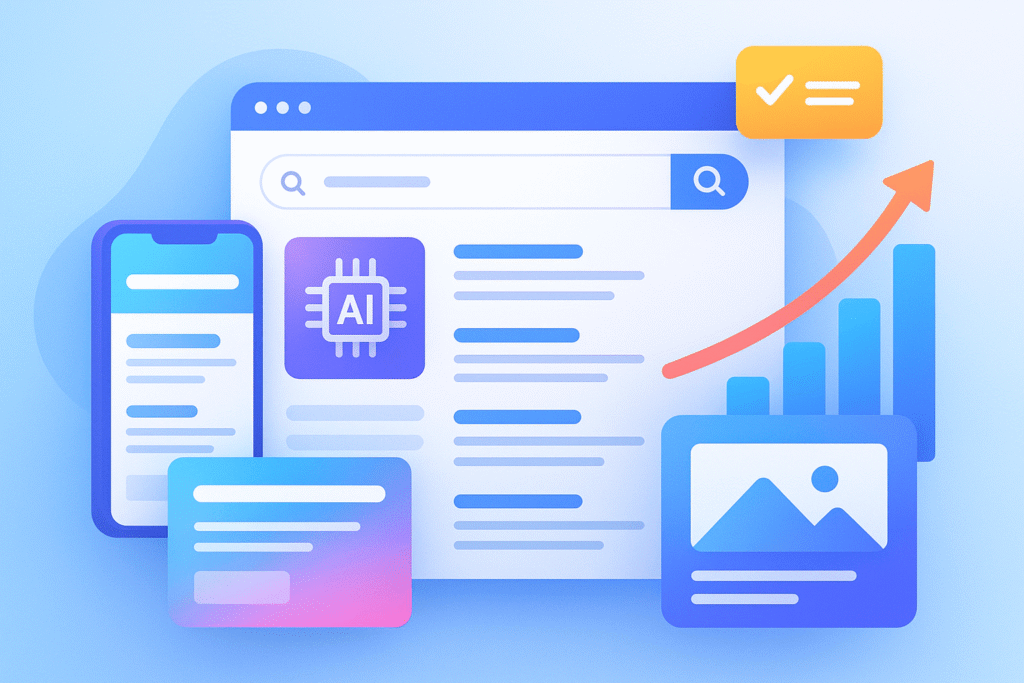Introduction: Why Search Isn’t What It Used to Be
Search engines have changed dramatically. In the early days, SEO was all about keywords, backlinks, and stuffing the right terms onto a page. But now, search results (SERPs) are dynamic. They include featured snippets, videos, FAQs, maps, “People Also Ask” boxes, and AI-driven results.
The way search engines measure relevance has shifted, and adaptive content structures are at the center of it. Instead of creating content that stays the same for everyone, adaptive structures allow flexibility—content that adjusts depending on device, intent, and context. This isn’t just a nice-to-have anymore; it’s becoming essential for ranking in evolving SERPs.
What Are Adaptive Content Structures?
Adaptive content is built to flex. It isn’t static; it changes depending on who’s looking at it and where. Think of it like a Netflix homepage—your experience isn’t identical to anyone else’s.
Why Static Content Falls Short
Static content is fixed. It delivers the same message regardless of the user’s intent, device, or behavior. That approach worked when search was simpler, but now it creates friction. Users expect content that “gets” them, whether they’re skimming on a phone, browsing on desktop, or searching via voice assistant.
Adaptive content solves this problem by presenting variations that fit user intent and context—without losing clarity.
How Search Engines Measure Relevance Today
Relevance isn’t just about keywords anymore. Search engines interpret intent, context, and user behavior.
From Keywords to Intent
If someone searches “best running shoes,” they might want reviews. If they search “buy Nike Pegasus size 10,” they’re ready to purchase. Adaptive content helps by shaping itself to serve both needs.
User Behavior as a Signal
Engagement metrics—like dwell time, bounce rate, and scroll depth—feed back into search engine algorithms. When users find content that feels tailored to them, they stay longer. That’s exactly what adaptive structures are designed to achieve.
Why Adaptive Content Matters for SERPs
Adaptive content isn’t just a UX perk—it directly influences how pages appear in SERPs.
- Device-based flexibility: On mobile, bite-sized summaries matter. On desktop, long-form depth is preferred.
- Personalization: Google already tailors results by location, history, and context. Adaptive content makes sure your page remains relevant across those variations.
- Machine learning alignment: As algorithms constantly update, adaptive content evolves alongside them instead of falling behind.
Key Elements of Adaptive Content
So, what makes content “adaptive”? Here are the foundational pieces.
Modular Content Blocks
Breaking content into reusable sections makes it easy to rearrange and serve different versions. Think product descriptions that expand or shrink depending on device.
Semantic Structuring
Schema markup and semantic HTML help search engines understand the meaning behind your content. Adaptive content relies heavily on this to surface in rich results and snippets.
Real-Time Adjustments
Examples: travel sites adjusting flight prices by location, or e-commerce platforms showing different product recommendations based on browsing behavior. This is adaptive content in action.
The Role of User Intent
User intent is the heartbeat of relevance. Adaptive content aligns directly with intent instead of making users dig for answers.
- Informational intent → articles, guides, how-tos.
- Transactional intent → product listings, CTAs, pricing.
- Navigational intent → quick links, directions, brand details.
By shaping to these needs, adaptive content signals relevance more clearly to search engines.
How to Build Adaptive Content Structures
Here’s how you can start implementing it:
- Design for multiple journeys – Create pathways for both casual readers and in-depth researchers.
- Use feedback loops – Analytics, heatmaps, and user testing reveal what’s working.
- Test and iterate – Adaptive content is never “finished.” Keep refining based on user behavior.
- Blend automation with human touch – AI can speed up adaptation, but human insight ensures quality and trust.
The Future of SERPs and Adaptation
Looking ahead, SERPs will only become more complex.
- Voice search: Queries are longer and conversational. Adaptive content must handle natural language.
- Visual-first results: Images, videos, and reels will dominate more searches.
- AI-driven answers: With search assistants summarizing content, only the most adaptable pages will surface.
Challenges to Watch Out For
Of course, adaptive content isn’t a magic switch.
- Over-adaptation: Too many variations can overwhelm users instead of helping.
- Automation overkill: Relying too much on AI risks losing the human connection. The key is balance.
Conclusion: Adapt or Get Left Behind
Search engines evolve, and so do user expectations. Static content simply can’t keep pace anymore. Adaptive content structures reshape relevance signals by aligning with intent, behavior, and context. The brands that embrace adaptability will win SERPs tomorrow. Those that don’t will fade quietly.
👉 Want to learn how to future-proof your SEO strategy with adaptive content? Visit SEO Sets to explore advanced insights and actionable guides.
FAQs
1. What makes adaptive content different from personalized content?
Adaptive content adjusts to broad contexts (like device or intent), while personalized content is tailored specifically to an individual.
2. Do adaptive structures really help SEO?
Yes. They improve engagement signals, which directly impact rankings.
3. Is adaptive content only for big brands?
Not at all. Even small businesses can use modular content, schema, and simple personalization to stay competitive.
4. How does adaptive content affect mobile SEO?
It ensures mobile users get streamlined, relevant experiences—boosting mobile rankings and usability.
5. What’s next for adaptive content?
Expect stronger integration with voice, video, and AI-powered SERPs, making adaptability non-negotiable.


